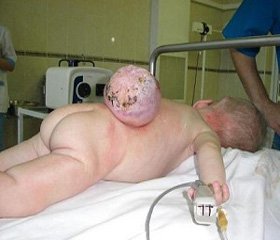Журнал «Здоровье ребенка» 7 (50) 2013
Вернуться к номеру
Anatomical features of congenitaldiaphragmatic hernia in children of different ages
Авторы: Slepov O., Veselskiy V., Slepov Е., Ponomarenko O., Soroka V., Dzham O., Ermolova G. - Institute of pediatrics, obstetrics and gynecology of NAMS of Ukraine, Department of surgical correction congenital malformations in children (chief m.d. Slepov O) Kiev.
Рубрики: Педиатрия/Неонатология
Версия для печати
Introduction. Congenital diaphragmatic hernia (CDH) is the displacement of abdominal organs into the chest through natural or abnormal opening in the diaphragm or by thrusting thinned aperture (all or only part of it) [1,2,3]. Children with CDH are high-risk patients. This anomaly presents considerable difficulties in treatment and diagnosis. The severity of the clinical condition in this category of patients is caused by respiratory dysfunction, pathological disorders of the cardiovascular and central nervous systems, gastrointestinal tract [1,2]. Especially dangerous is acute manifestations of the disease that can develop in any age, often under the guise of intestinal obstruction, pneumothorax and other diseases [4, 5].
Frequency CDH is 1 to 4000 live births, representing 8 % of all severe congenital malformations. In taking into account a large group of stillbirths with disabilities diaphragm CDH frequency is 1 in 2000 live births [1, 2, 6-8]. From 5 to 30 % of CDH remain undiagnosed until an older age, and in some cases is a random post mortem discovery [4-7, 9].
Late diagnosis of this anomaly depends on the time of onset of clinical symptoms and anatomical features of CDH. Location and size of the defect diaphragm and the nature of the contents of hernias sac in children of all ages causing a wide range of clinical symptoms [10-13]. Therefore, the anatomical features of the various types of CDH are very important to evaluate the diagnostic and therapeutic tactics.
The aim of the research - to explore anatomical features of congenital diaphragmatic hernia in children of all ages.
Characteristics of children and methods. In the department of surgical correction of congenital malformations SI "IPOG NAMS of Ukraine" from 1987 to 2012 were analyzed the histories of 92 children aged 1 month to 15 years with various congenital diaphragmatic hernias who were treated in this department.
Results. The analysis of anatomical features at different variants of CDH in 76 operated children was performed. Anatomical features of CDH were studied in 48 children, among them 33 - with hernial sac (true CDH) and 15 - without hernial sac (false CDH).
CDH with hernial sac were often left sided- 63,3 % (n = 21) and less frequently right sided - 33,3 % (n = 11), with P> 0,05 and two-sided 3 % (n = 1). In 97 % (n = 32) CDH was the primary and in 3 % (n = 1) recurrent.
localization of the defect CDH with hernial sac:
a) the central part of the diaphragm - 42,4% (n = 14);
b) posterio-lateral part 27,3% (n = 9);
c) posterio-medial part 3% (n = 1);
d) the total defeat of the diaphragm - 15,1% (n = 5);
e) anterior part (n = 2), anterio-lateral (n = 3) or anterio-medial part of the diaphragm (n = 3) - 24,2% (n = 8).
The sizes of muscle defects CDH with hernial sac varied from 12 to 180 cm2 on average 58,8 ± 5,45 cm2.
The sizes of muscle defects CDH without hernial sac reached 5 to 80 cm2 on average 28,4 ± 3,72 cm2.
Conclusions.
1. In cases of false CDH defect was significantly more left-sided, P <0.05. At true CDH this pattern was not. The sizes of defects in the diaphragm false CDH 28,4 ± 3,72 cm2 were significantly lower than defects in real CDH 58,8 ± 5,45 cm2 at P < 0.01.
2 In cases of false CDH significantly more frequently than in true CDH, the hernia contents were colon and small bowel and the great omentum, P < 0.05. In another hernia contents significant difference in frequency was not. There was no significant difference in the frequency localization and structure of the muscle edges of the defect in the diaphragm false and true CDH. Within the group of true CDH was significant difference in the incidence of muscle structure platen aperture edges of the defect, as opposed to false CDH, where this difference was not.
3. In cases of Morgagni hernia (parasternal), hernial contents are transverse colon and / or liver. Unlike the CDH, the parasternal hernia content was not such organs as the stomach, spleen, greater omentum, small intestine, pancreas and kidneys.
4. There was not significant difference in the size of the hernia defect in esophageal and paraesophageal hernia. Esophageal hiatal hernia content was stomach. In case of the esophageal hernia mucosa of the stomach herniated into the esophagus. The esophagus in this case has always been extended and shortened. In contrast, the content of paraesophageal hernia, was in the posterior mediastinum, the right or left of the midline, parallel to the esophagus. Moreover did not enlarged and not shortened.

